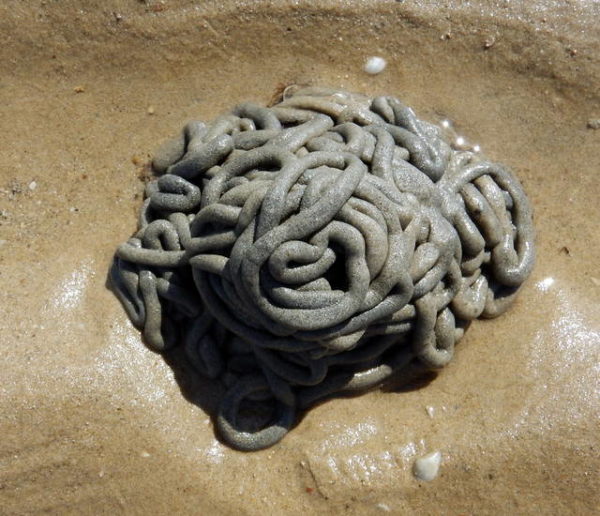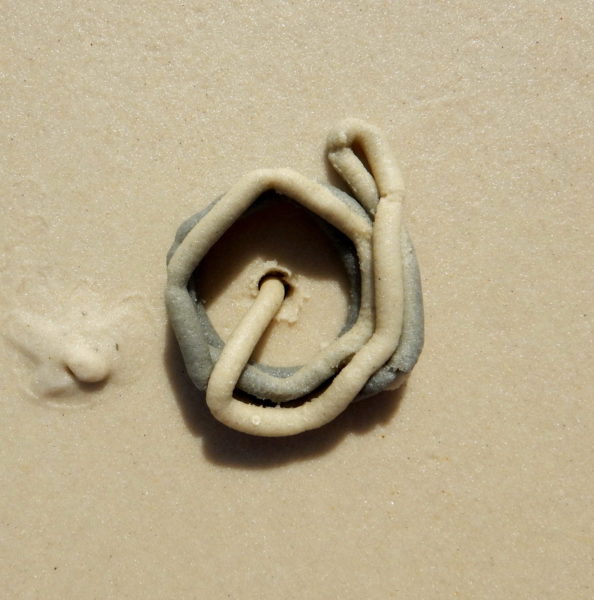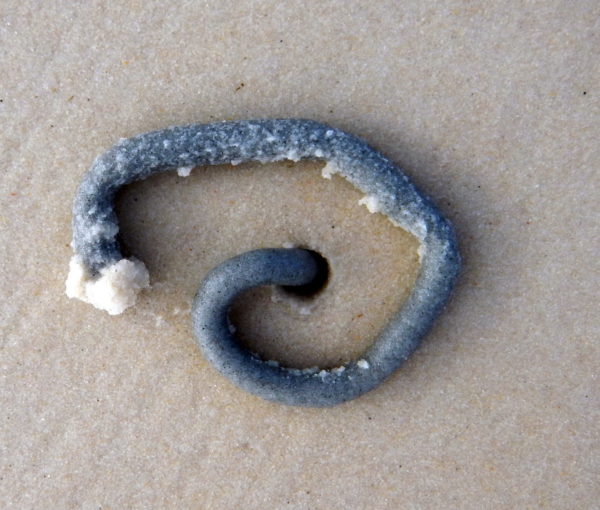Published in the Ocean Watch column, Honolulu Star-Advertiser © Susan Scott
August 19, 2017
My nephew, Joe, pointed out an area of exposed sand during a low-tide walk in Australia.
“There sure is a lot of poop here,” he said.
“These piles aren’t poop,” I said, of the squiggly pyramids at our feet. “They’re sand cleaned by acorn worms.”
“What are acorn worms?”
“I would have to kill one to show you.”
I wasn’t joking. An acorn worm’s skin is so thin that when it’s full of sand, which is nearly always, the creature bursts open if you pick it up.
 An acorn worm leaves behind a mound of expelled sand
An acorn worm leaves behind a mound of expelled sand
that it has ingested while looking for organic matter.
©2017 Susan Scott
Besides, acorn worms aren’t exactly cute and cuddly. Each of the 70 or so species in the world’s oceans looks like a slimy piece of intestine with an acorn for a head and a neck that looks like a cervical collar, the brace people wear for neck injuries.
But even if these marine creatures won’t win any beauty contests, they’re tops in talent. The mushy housekeepers live under the surface from the shoreline to 10,000 feet, cleaning up the ocean’s organic wastes. The worms suck in sand, pick out and eat dead plant and animal material there and discharge the filtered sand in distinctive coils.
Hawaii’s acorn worms grow 1 to 18 inches long, the longer with a body diameter of 1 inch. North Carolina hosts the giant of the U.S., a worm that grows to 8 feet long and digs burrows nearly 10 feet long. The species ranges to Brazil.
An acorn worm’s rounded, muscular head does the digging. The collar serves as an anchor, and the body trails behind. Both head and collar contain glands that produce slick mucus that helps the worm slip through sand and mud.

Other glands make bromine, a chemical with a medicinal smell. This, along with the accumulation of iodine in the body, might protect the worm from infection and/or predators. Given that these slow-moving worms have no teeth or claws, chemicals are their only defense.
In Hawaii, Gould’s auger snail eats only acorn worms. The worm-eating livid cone snail preys on acorn worms.
An acorn worm has no brain, but some nerves. Sensory cells on the head can taste incoming particles. The mouth lies at the junction of the head and collar, and when the worm meets something inedible, it ducks its head into the collar. This closes the mouth like a plug in a drain.
The anus is where you’d expect, on the rear end.
As we walked among the endless acorn worm castings of Queensland’s Pancake Creek, Joe said, “The worms push the sand out from where?”
“From their anuses,” I said.
“Um, Aunt Susan? That’s what people call poop.”
Technically, he’s right. The mounds, called fecal casts, contain the worm’s feces. Still, those are minuscule compared with what was in the sand when the worm ingested it. Call the acorn worm’s sand coils what you will. Given my fondness for marine worms, I call them cool.
